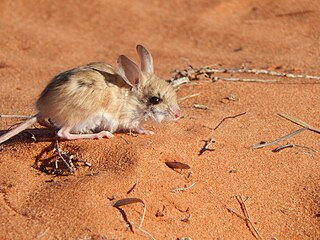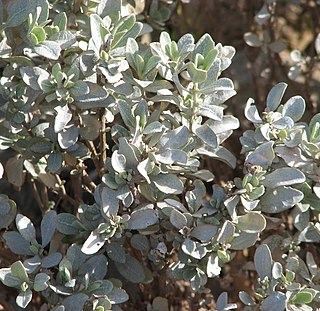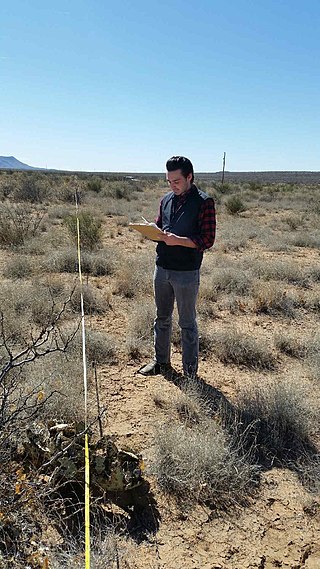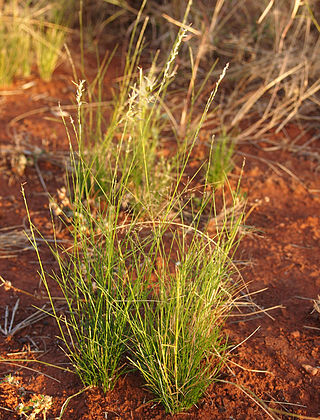Related Research Articles

A savanna or savannah is a mixed woodland-grassland biome and ecosystem characterised by the trees being sufficiently widely spaced so that the canopy does not close. The open canopy allows sufficient light to reach the ground to support an unbroken herbaceous layer consisting primarily of grasses. Four savanna forms exist; savanna woodland where trees and shrubs form a light canopy, tree savanna with scattered trees and shrubs, shrub savanna with distributed shrubs, and grass savanna where trees and shrubs are mostly nonexistent.

The dusky hopping mouse, is a small rodent endemic to Australia, inhabiting desert regions characterised by sand dunes. Populations have experienced significant declines since the arrival of Europeans, and continue to be subject to threatening processes. It is currently listed as a threatened species.

Acacia aneura, commonly known as mulga or true mulga, is a shrub or small tree native to arid outback areas of Australia. It is the dominant tree in the habitat to which it gives its name (mulga) that occurs across much of inland Australia. Specific regions have been designated the Western Australian mulga shrublands in Western Australia and Mulga Lands in Queensland.

Rangelands are grasslands, shrublands, woodlands, wetlands, and deserts that are grazed by domestic livestock or wild animals. Types of rangelands include tallgrass and shortgrass prairies, desert grasslands and shrublands, woodlands, savannas, chaparrals, steppes, and tundras. Rangelands do not include forests lacking grazable understory vegetation, barren desert, farmland, or land covered by solid rock, concrete and/or glaciers.

Santalum spicatum, the Australian sandalwood, also Waang and other names (Noongar) and Dutjahn (Martu), is a tree native to semi-arid areas at the edge of Southwest Australia, in the state of Western Australia. It is also found in South Australia, where it is protected and listed as a vulnerable species. It is traded as sandalwood, and its sandalwood oil has been used as an aromatic and a food source over history. S. spicatum is one of four Santalum species occurring in Australia.
CSIRO Publishing is an Australian-based science and technology publisher. It publishes books, journals and magazines across a range of scientific disciplines, including agriculture, chemistry, plant and animal sciences, natural history and environmental management. It also produces interactive learning modules for primary school students and provides writing workshops for researchers.

Yule Brook Botany Reserve, also known as Yule Brook Reserve and Cannington Swamps, is a 34.6-hectare (85-acre) parcel of land in the Perth, Western Australia suburb of Kenwick. It is owned by the University of Western Australia, and used by them for botanical research and teaching.

The inland broad-nosed bat is a species of vesper bat. They are endemic to Australia and widespread throughout the inland, especially in arid and semi-arid regions. This insectivorous microbat, measuring 12 centimetres (4.7 in) in length, roosts in tree hollows during the day and forages over woodland and water at night.

Atriplex vesicaria, commonly known as bladder saltbush, is a species of flowering plant of the family Amaranthaceae and is endemic to arid and semi-arid inland regions of Australia. It is an upright or sprawling shrub with scaly leaves and separate male and female plants, the fruit often with a bladder-like appendage.
Brian Harrison Walker is a scientist specialized in ecological sustainability and resilience in socio-ecological systems.

The flora of Australia comprises a vast assemblage of plant species estimated to over 21,000 vascular and 14,000 non-vascular plants, 250,000 species of fungi and over 3,000 lichens. The flora has strong affinities with the flora of Gondwana, and below the family level has a highly endemic angiosperm flora whose diversity was shaped by the effects of continental drift and climate change since the Cretaceous. Prominent features of the Australian flora are adaptations to aridity and fire which include scleromorphy and serotiny. These adaptations are common in species from the large and well-known families Proteaceae (Banksia), Myrtaceae, and Fabaceae.

The Paroo-Darling National Park is a protected national park that is located in the Far West region of New South Wales, in eastern Australia. The 178,053-hectare (439,980-acre) national park spans two distinct regions in the outback area. This region covers the arid catchments of the Paroo River and the Paroo-Darling confluence to the south.

The North Australian Pastoral Company (NAPCO) is a large, privately owned, Australian cattle company which operates 14 cattle stations covering over 60,000 km2, managing around 200,000 cattle, throughout Queensland and the Northern Territory. It produces beef cattle which are pasture raised and grain finished before sale to Australian meat processors, who onsell beef to domestic and international customers.

Holistic Management in agriculture is an approach to managing resources that was originally developed by Allan Savory for grazing management., Holistic Management has been likened to "a permaculture approach to rangeland management". Holistic Management is a registered trademark of Holistic Management International. It has faced criticism from many researchers who argue it is unable to provide the benefits claimed.

Veronica Perrule Dobson is an Eastern Arrernte linguist, educator, elder, Traditional Owner, author and ecologist. She is instrumental in establishing Eastern Arrernte as a written language.

Rangeland management is a natural science that centers around the study of rangelands and the "conservation and sustainable management [of Arid-Lands] for the benefit of current societies and future generations". Range management is defined by Holechek et al. as the "manipulation of rangeland components to obtain optimum combination of goods and services for society on a sustained basis". The United Nations (UN) has declared 2026 the International Year of Rangelands and Pastoralists, with the Food and Agriculture Organization leading the initiative.

Eragrostis setifolia, commonly known as neverfail grass, is a species of perennial grass in the family Poaceae native to Australia, where it is widespread and common throughout the range lands and is commonly utilized as a pasture grass. According to IUCN classification it is listed as a least concern species throughout most of its range with the exception of Victoria where it is classified as vulnerable. It is capable of C4 photosynthesis.

Atriplex holocarpa is a low-growing species of Atriplex (saltbush) found throughout arid regions of Australia. A. holocarpa is commonly known as pop saltbush, because its carpals pop when stepped upon.
Mark Westoby is an Australian evolutionary ecologist, emeritus professor at Macquarie University, and a specialist in trait ecology.

Chrysopogon fallax is a perennial tufted grass endemic to Australia found in all mainland states except Victoria. It is commonly known as golden beard grass, ribbon grass, and weeping grass.
References
- ↑ "Dr Margaret Friedel: contributing to arid land sustainability". CSIRO. Archived from the original on 20 July 2014. Retrieved 14 August 2014.
- 1 2 3 "Dr Margaret Friedel". CSIRO. Retrieved 5 February 2019.
- ↑ "Margaret Friedel". Charles Darwin University. Retrieved 7 October 2023.
- 1 2 3 "ARS Member Profile - Margaret Friedel". Australian Rangeland Society. Retrieved 5 February 2019.
- ↑ Grice, A. C.; Murphy, H. T.; Clarkson, J. R.; Friedel, M. H.; Fletcher, C. S.; Westcott, D. A. (7 December 2020). "A review and refinement of the concept of containment for the management of invasive plants". Australian Journal of Botany. 68 (8): 602–616. doi:10.1071/BT20092. ISSN 1444-9862.
- ↑ Grice, A. C.; Murphy, H. T.; Clarkson, J. R.; Friedel, M. H.; Fletcher, C. S.; Westcott, D. A.; Grice, A. C.; Murphy, H. T.; Clarkson, J. R.; Friedel, M. H.; Fletcher, C. S.; Westcott, D. A. (7 December 2020). "A review and refinement of the concept of containment for the management of invasive plants". Australian Journal of Botany. 68 (8): 602–616. doi:10.1071/BT20092. ISSN 1444-9862.
- ↑ Friedel, Margaret H.; Morton, Stephen R. (7 November 2022). "A history of CSIRO'S Central Australian Laboratory, 1: 1953–80: pastoral land research". Historical Records of Australian Science. 34 (1): 36–49. doi: 10.1071/HR22006 . ISSN 1448-5508.
- ↑ Friedel, Margaret; Allan, Grant E.; Duguid, Angus (2014). "Do we know enough about vegetation dynamics to manage fire regimes in central Australia?". Ecological Management & Restoration. 15 (2): 128–132. doi:10.1111/emr.12104. ISSN 1442-7001.
- ↑ "Outstanding Achievement Awards". Society for Range Management. Retrieved 5 February 2019.
- ↑ "Public Service Medal (PSM)" (PDF). 2007. p. 374. Retrieved 5 February 2019.
- ↑ "From the desk of the Managing Director in June" (PDF). Desert Knowledge CRC. Retrieved 5 February 2019.
- 1 2 "Margaret Friedel". Charles Darwin University. Retrieved 7 October 2023.
- ↑ "A million years of change: wind, flood and fire in the Simpson Desert". Biting The Dust. Retrieved 5 February 2019.
- ↑ "IPCC WGII - Access to AR4 Review Comments". Archived from the original on 14 August 2014. Retrieved 14 August 2014.
- 1 2 3 4 "Council Announces Australian Rangeland Society Fellowship for Dr. Friedel". January 2017. Retrieved 5 February 2019.
- ↑ Thad Box (2008). "A Conversation With Margaret Friedel". 32 (2).
{{cite journal}}: Cite journal requires|journal=(help)